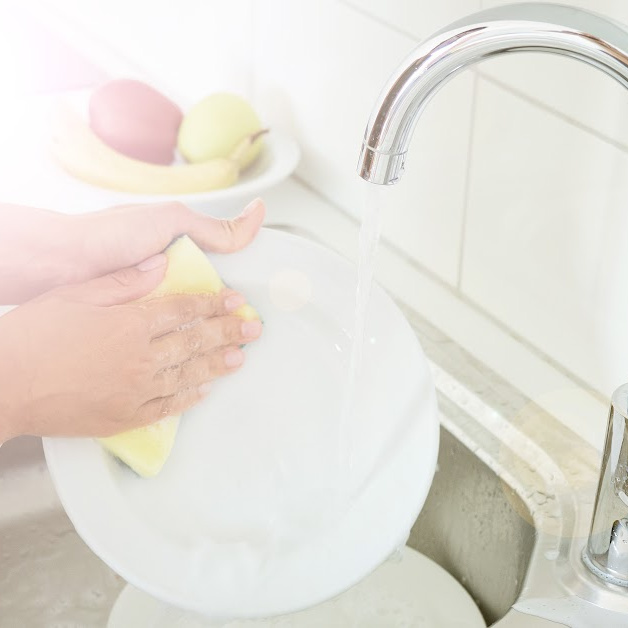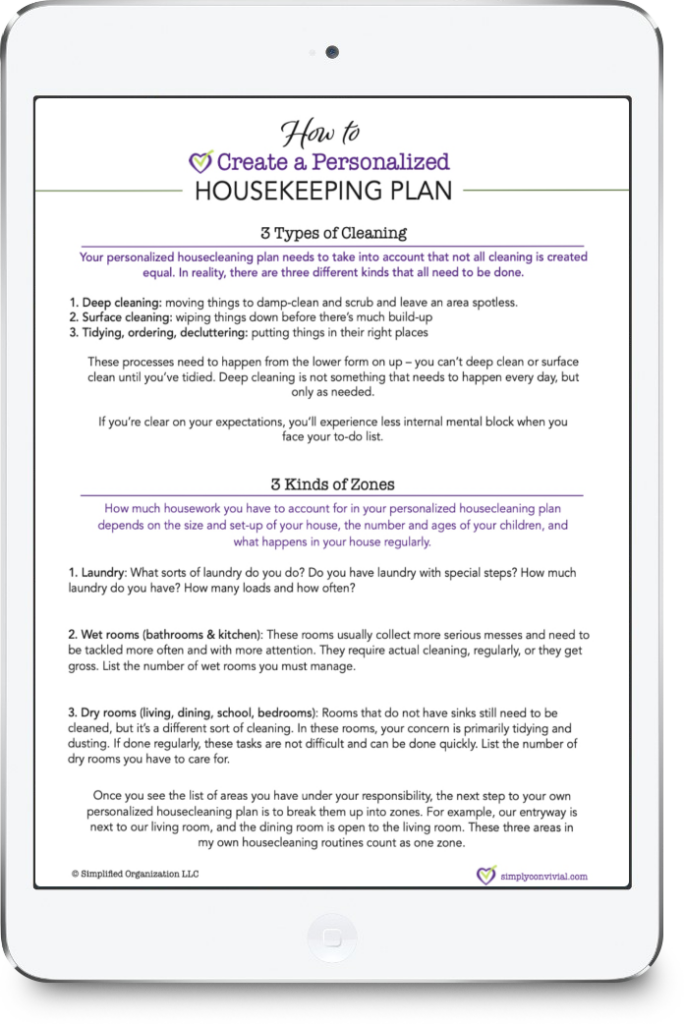How many times have you sat at the table with your calendar and a notebook, listing out what needs to be done, looking at the lay of your week, and determining what should happen when?
You create a plan to get all the housework done on a consistent basis so nothing ever gets out of hand.
The first week, you work your plan. It seems to work – mostly – except that it takes more time than you thought. That’s ok. You know that if you stick with it for a few more weeks, not only will it not take you as long, but you’ll also gain the upper hand in your home and eventually things will be mostly clean, most of the time.
There’s only one problem.
You don’t stick with it for a few more weeks.
The second week, it’s hit or miss, and you get to it about half the time.
So you start the following week looking over the plans, reminding yourself how great it works, and commit to solidly following your written routines this week.
Then you only do on Monday, totally dropping the ball for the rest of the week.
Or is that just me?
And maybe this is just me, also, but what is the next step after the routine totally breaks down in week 3?
Obviously, it means sitting down at the table again, notes spread out, pencil busy scratching, working out a new plan, since the previous one didn’t work.
Time for a new plan, a new commitment, a new week with a fresh start.
Again and again, we create whole new routine systems to make sure everything gets covered. The only thing that seems to change is long we go between the breakdown of one set of routines and the brainstorming of the next new set.
Why most routines don’t stick
Most of us are great at putting a routine on paper, but when it comes to following that written plan, we fall far short of it. There are two main reasons for that.
First, we lack the skill of follow-through. Consistent, disciplined people who have no trouble with their routines have practiced follow-through long enough that it is a habit, a character trait.
Consistency of this sort isn’t necessarily an inborn ability or a personality trait. It’s a habit that’s been built up by repeated practice over years. Most women who have it, for whom it appears natural, began forming the habit in childhood.
For those of us who did not form the habit of follow-through as children, there is still hope.
We won’t be zapped with the ability to reliably follow-through on our tasks simply by designing the greatest routines on paper.
Instead, we build our ability over time.
Second, our unrealistic expectations feed into our lack of consistency. As we work and try to improve, we often strive for an ideal that is unrealistic. Deep down, we know we’ll never achieve it, and so we lack heart to really attempt to be consistent. Why work hard to meet an impossible goal?
If our goal is a house that is never messy, always clean, with zero clutter, we’ll never get there while we have children at home no matter how consistent our chores are. The only way to get close is to sacrifice our children’s fellowship and development on the alter of our housekeeping standards.
Sensing this clash of values, we’ll give up our housekeeping standards and yet berate ourselves for doing so because we haven’t identified the true problem.
Routines do not inspire or motivate
Having routines in place is nice, but routines themselves look pretty dull. Part of their lack of appeal is that we dislike repetition, but the other part is that routines are a backbone – meant to be uninteresting and stable, not exciting.
We’re used to being motivated by excitement, by inspiration. Commercials are loud, bright, and over-the-top because excitement is the easy button when it comes to motivation. After decades of commercial-watching, we’re accustomed to having our easy-button pressed. On top of that, prizes and rewards – treats, sugar, fun toys – are used most of our childhood to motivate us to do well.
Routines are not glitzy, not bright, and not fun or sweet. So we struggle to find inspiration or motivation in them.
Cultures that were better about routines and regularity found duty to be a motivating factor. Those societies taught their young that duty was inspiring. Americans have been told duty is oppressive, and so it’s no wonder stability-giving habits are difficult for us.
We can’t undo our culture, our enculturation, our upbringing, but we can begin down a new path. We start by acknowledging that the easy-button won’t happen here.
Even the routines themselves, once in place, aren’t an easy button. We have to continually remind ourselves that virtue really is rewarding, even if it isn’t fun or sweet.
You can’t make routines from scratch
One mistake I have made more often than I can count is to start making up my routines with only a blank sheet of paper in front of me. I want a new set of routines from scratch.
Such routines are doomed from the beginning. The best way to build routines, to build habits, is to connect them to the existing patterns of your day.
So to make home routines and rhythms that work, we need to connect the new routine to an existing routine. That probably means we need to begin by even noticing what our existing daily rhythms are.
How are you currently starting your day? When do you normally break for meals or transition to other activities?
These are the moments we can harness, tying new and improved routines to these parts of our day.
Don’t start with a full set of routines
The other mistake we often make when we write out a brand new plan is that we create a full and complete system that will address every area and – supposedly – fix every problem.
Such overambitious plans never come to fruition because it’s more than we can manage.
We can’t manage a full set of routines, a complete system, for two reasons.
First, such systems usually do not take into account our real life and situation. Systems imagined from the ground up neglect to take into account toddlers needing discipline or days spent at the park because the weather is nice. We don’t realize how ingrained our pattern of zoning out on our phone with our coffee is, so we think we can just stop it because we wrote out a new plan.
We forget that the work needed to get a chaotic house in order is not the same as the work needed to maintain an orderly home. We don’t budget for variation in activity, recognizing that weekends that involve hospitality will take more recovery work than those that don’t.
Systems are rather unforgiving that way.
Second, we simply aren’t in good enough shape to execute complete systems yet. It’s too far beyond our capability, so we crash and burn.
We wouldn’t say, “I want to be in shape and be able to run a marathon,” and so sign ourselves up for a marathon on Monday, showing up in running shoes and expecting to just do it. But that’s what our brand new home system is like.
Start a routine training program
Just like you’d have to set up a training program to become a runner, so we need a training program for becoming more consistent housekeepers who manage routines cheerfully and well.
Our abilities, our endurance, our skills, build up over time with practice.
Baby steps, added to gradually, are how we improve our routines and rhythms at home. There is no easy button and no instant “turn over a brand new leaf” program.
Practice, practice, practice, building up small chore after small chore, one atop another, over time, is how we grow in consistency.
It is slow, gradual work, but slow change bears fruit much faster than the overnight overhaul – because those overhauls, we know, never stick and don’t actually get us anywhere.
So pick one small chore, not a complete routine system, and get consistent with it over two months. Build your consistency muscle with practice in a small thing. It will grow and bear fruit in surprising ways.



